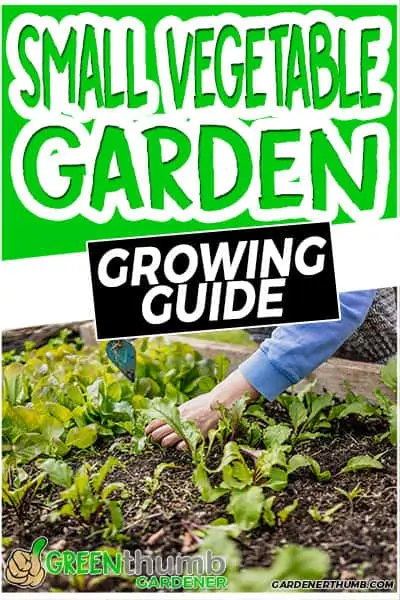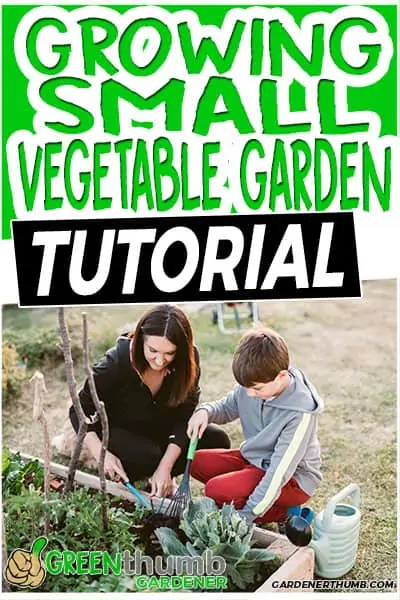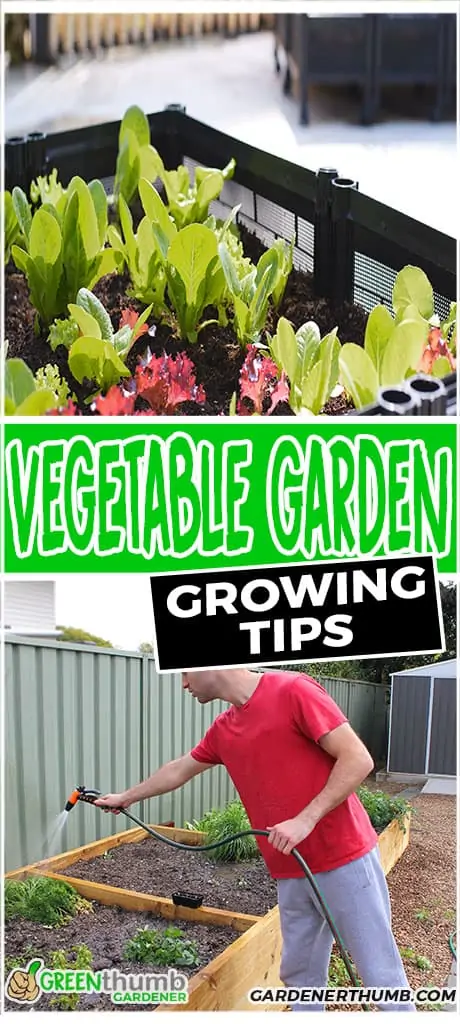Guide On How To Grow A Small Vegetable Garden
Last updated:10/30/21
You might want to know how to grow a small vegetable garden because of the limited space or the particular veggie to grow. These are valid concerns, especially if you do not have sufficient info.
I once had the same questions while I was trying to grow my vegetables.
Ever since then, I have grown more vegetables and become an expert in gardening.
Here is a guide for you on how to go about it too.
Green thumb Gardener occasionally links to product and/or services offered by vendors to assist you with all your gardening needs. Some of these may be affiliate links, meaning we earn a small commission if items are purchased.
Want to Download a Garden Hack Guide for FREE

Enter your email below and we will send you a guide to help you SAVE money in your garden.
How Much Space Do You Really Need?
You do not need much room if you’re considering a small garden. One of the things you have to consider when you want to go into vegetable gardening is space. This is often a consideration that comes to the mind of many.
Whether you are a hobbyist or doing it for commercial purposes, you’ll have to consider the amount of needed room and whether you can get that space.
Different things determine the amount of land you need. If you are growing your plot for summer meals, the requirements will be different.
If you’re growing your garden to serve your needs all year round, the requirement will also be different. These things vary because the yields you will expect of the garden equally vary.
Here are a few guidelines you can work with to get the best vegetable gardens.
Beginner
If you’re a beginner, and you’re looking for a moderate place to start with, you do not need to get a big space. You can start with something as small as a 10×10 gardening zone which is enough for larger plants.
With this amount, you can grow your favorite veggies. Get the plant of each of these veggies, and grow the plants in your garden. This will offer you a moderate yield when harvest comes.
The moderate size will serve your needs because, with it, you can have control over the entire garden and also choose how to operate. This makes for ease and convenience.
You do not have to worry about taking care of too much. It also affords you the time and opportunity to learn more about your veggies and get better strategies to grow them.
By doing so, you also get to become a better gardener with fresh veggies.

Intermediate
Following your beginner stage, you’ll gradually become more acquainted with your garden. By this period, you know more and can take on more.
At this stage, it is safe for you to expand your garden to up to 500 feet. This will offer you more edible plants and should be able to serve the needs of your family. You become more aware of companion plants.
If you run a family of about four people, this garden will serve all of you and still have some yields left. You should note that maximizing your garden is to plan to divide the garden into 100 feet per person.
This way, you can adequately provide for everyone in the house.
Advanced Level
You’ll gradually continue to grow as a gardener till you become an expert. By this stage, you can take up larger gardens to serve your family’s needs over a long period. You know your planting dates and have mastered companion planting.
If you want to get ambitious about your gardening, you can improve the space used up to 200 feet per person. This will give you a larger garden, and this way, you can get more yields.
Maube you are looking to commercialize your yields such that you sell the yields you get from your area, you’ll have to expand the size to serve the needs of many people. By doing so, you’ll have more things to harvest and sell.
If you are looking towards serving many people, you’ll have to expand the size. But if you want to keep it small, all you really need is a small space as well. You can use your yard.
Choosing Vegetables For Your Small Garden
Choosing the right kind of veggies that can serve your small plot’s needs is an essential thing. This is because, if you choose the wrong vegetables, you’ll have a problem managing the veggies and making the most out of them.
There are certain veggies that only fit the purpose of large plot. If you choose these kinds, you won’t get a bountiful harvest.
Here are a few things to consider for your small garden.
Compatibility
You need to ensure that the plant you’re growing on your soil is compatible with the soil. Often, beginner gardeners stress their soil by planting vegetables that do not match the soil.
This only makes the process difficult and prevents the vegetables from growing as they should.
When you grow a wrong vegetable, and it refuses to grow as you want, you might become frustrated, not knowing that it’s an issue of compatibility.
To ensure that you do not expend your energy taking care of vegetables that are not fit for your purpose, ensure you consider the compatibility of the veggies you intend to grow.
Check your soil, space, water requirement, and determine the right kind of veggies that will fit in.
Crops That Will Help You Save Money
It is crucial that you focus more on money-saving crops. These are the crops that will help you spend less. One of the reasons people venture into gardening in the first place is to produce certain vegetables without having to buy from the market.
You will be growing your vegetables, it makes sense that you choose vegetables that are costly in the market.
By growing these vegetables, you get to save a lot on the amount you expend on buying them. For instance, arugula and spinach can cost up to $4 in the market, but you can spend about $2 to purchase a pack of seeds and plant the seeds.
You can have a supply of these crops over a long period. This means you’ll save a lot on the amount you otherwise would have spent buying those crops.
Caring For The Vegetables
You also need to consider the commitment level that the vegetables will require. I have grown certain veggies that needed me to garden with care.
During this period, I had to allocate a sizable time to my garden. If you are the type who doesn’t have much time to spare watering and cater to your veggies’ needs, you should look towards growing the kind of veggies that won’t stress you.
Some veggies require constant watering, among other things. As such, you should know the ease of care concerning the vegetables you select.
This will help to ease your burden and fit your schedule while you get your garden running.
By doing so, everybody wins.
Top 5 Crops For Small Vegetable Gardens
Knowing the right crops to grow in your small vegetable garden is an important thing. Keep in mind that you will need high-quality seeds when you get a seed packet.
Here are the top 5 crops you can grow.
1. Leaf Lettuce
Plant cool-season crops during early or late Spring after the spring frost or Fall to ensure you have a good mix in your garden plans.
Leaf Lettuce is one of the crops you can grow in your small vegetable garden. This plant is one of the fast-maturing varieties and can serve your needs all year round. When you harvest your leaf lettuce, it grows back in the same spot.
All you need to do is ensure that it gets an adequate supply of rich garden soil, and you are watering it as you should.
By doing so, the plant will continue to offer impressive yields and plant growth.
This is a vegetable you can grow in even smaller spaces like your containers and pots. You do not have to worry much about growing these veggies.
Grab some lettuce seeds and start planting.

2. Tomato Plants
Do you like to get your tomatoes straight from the farm? Do you salivate over the photos in the seed catalogs? Then you should grow your tomatoes in your small garden right away.
Maybe you are looking to start a small garden bed, and you’re considering what to grow, tomato plants are some of the best veggies you can grow.
They not only grow at a fast rate but also offer impressive yield weight per plant.
By taking care of your garden, and supplying the tomatoes all it needs to grow, you can have a sufficient supply of tomatoes to serve your family needs every time you desire.
You can get to have that “straight from the farm” feeling.
Tomato plants will augur well in your pots and containers. Ensure you place them in a sunny location with an adequate light. Pair them up with heirloom variety basil plants if you want a caprese salad.
3. Cucumbers
Looking for what to grow with your small space?
Why not consider cucumbers as one of the many upward-bound plants. Cucumber plants do not take a lot of space to flourish once you know the hacks. All you need to provide is a place for the plants to climb once they start to grow.
With your backyard, you can efficiently plant these veggies and harvest them once they are ready. They also offer impressive yields that will serve your family and also serve the purpose of giving away if you so feel like it.
If you are looking to grow your cucumbers in your pots, try to get compact pots. They will best suit the purpose. The cucumber vines will only take a few feet with its spreading.
You can sub out green beans or pole beans if you don’t care for cukes.
4. Squash
You might wonder whether you can truly grow squash in your garden without it consuming the entire space. There is a bit of truth in this.
If you do not curb your squash, you might end up having it take over the garden. However, with an adequate amount of care, you can control it.
To ensure that your squash grows moderately, plant it vertically. This way, it will not only grow nicely but also offer much output during the harvest period. This is one of the veggies that not only offer you impressive yields but also beautify your garden and your environment.
5. Peppers
A variety of pepper called bell pepper is one of the finest veggies you can grow in your garden. Peppers grow all the way up, thereby making them consume much less space since they do not spread about.
You can grow them on your landscape or in a pot.
They grow fast and offer sufficient yields that can serve your needs. Also, growing pepper comes with an impressive level of ease of care.
You do not have to stress so much about the growth.
Consider Using Containers For Your Garden
You should consider using containers or pots for your garden. If you are short of space and you want to grow a garden, one of the most effective ways you can go about it is by using pots or containers.
This is one of the ways I grow my garden. So many homeowners are into container gardening. It is a perfect way to get maximum results with very minimal input and regardless of the location.
Container gardening works well with your little space. This is something you can grow in your backyard. All you need to do is to understand the nature of the veggies you’re growing and their compatibility with this kind of gardening.
You have to consider the sunlight per day that your backyard gets. If you are growing a vegetable that requires sunlight, you’ll have to place it in the part of your yard that receives at least 5-6 hours of sunlight.
If the vegetable doesn’t require much direct sunlight, you’ll equally have to place it in light shade.
Final Thoughts
Growing the right kind in a healthy vegetable garden is quite an important thing. This is to ensure that you don’t encounter problems that will undermine your effort.
Understand the best way to put your small area to use. Consider your backyard, the sunlight, and the right kind of plants that fit a small space. This way, you can get your veggies right from the farm as well.
Related Questions
What Are The Easiest Vegetables To Grow In A Garden?
The easiest vegetables to grow in a garden are those that do not require much to produce impressive yields. Some of these include peppers, lettuce, squash, cucumbers, & homegrown herbs among others.
What Veggies Come Back Every Year?
Some veggies can serve you all year round. They include leaf lettuce, some herbs and peppers. Many of these like lettuce are succession plantings so you can grow a few times throughout the season.









